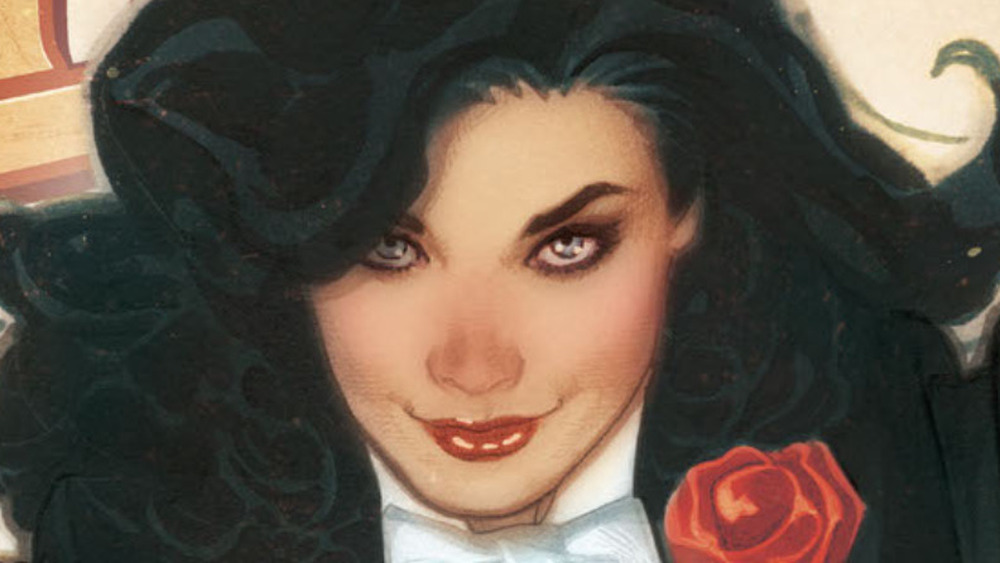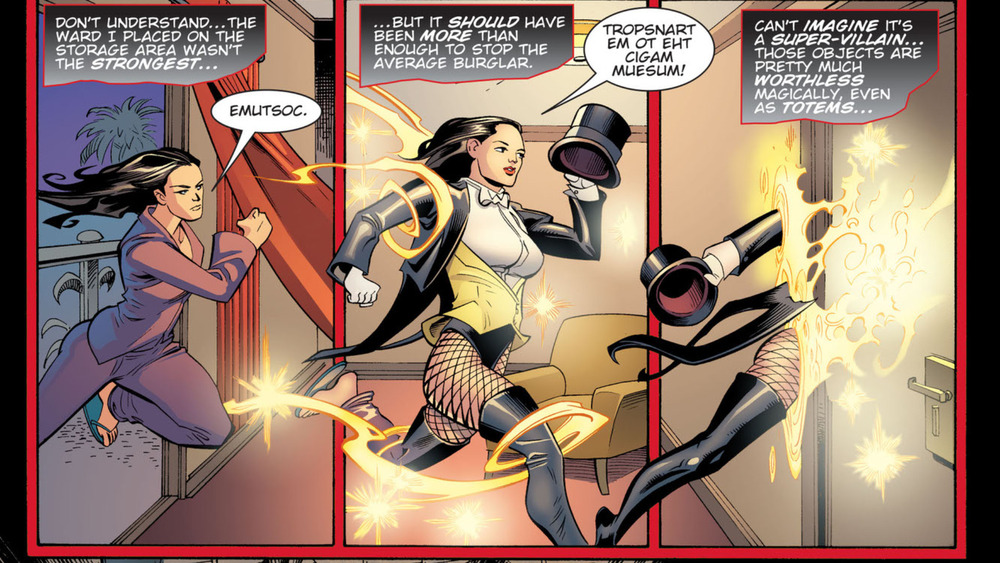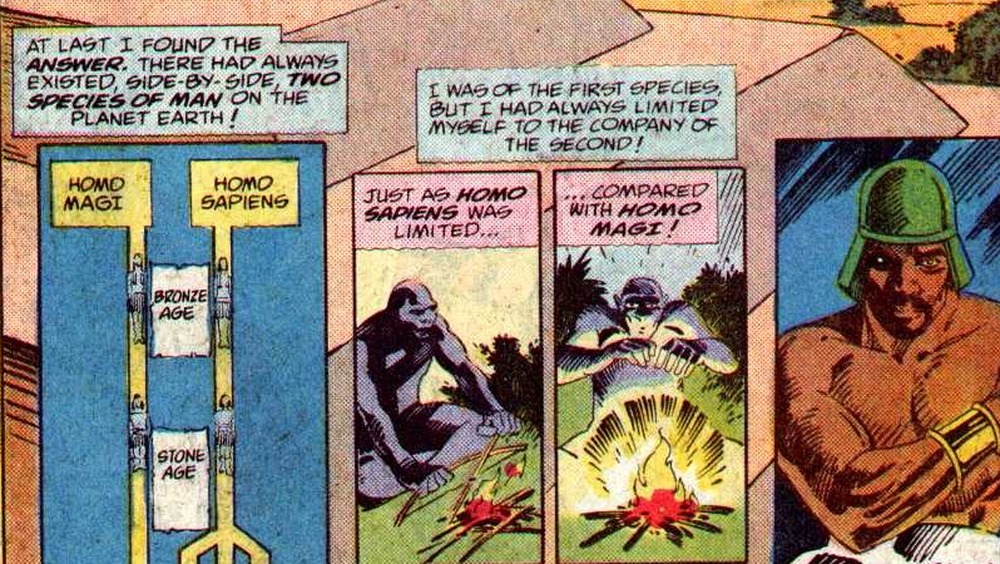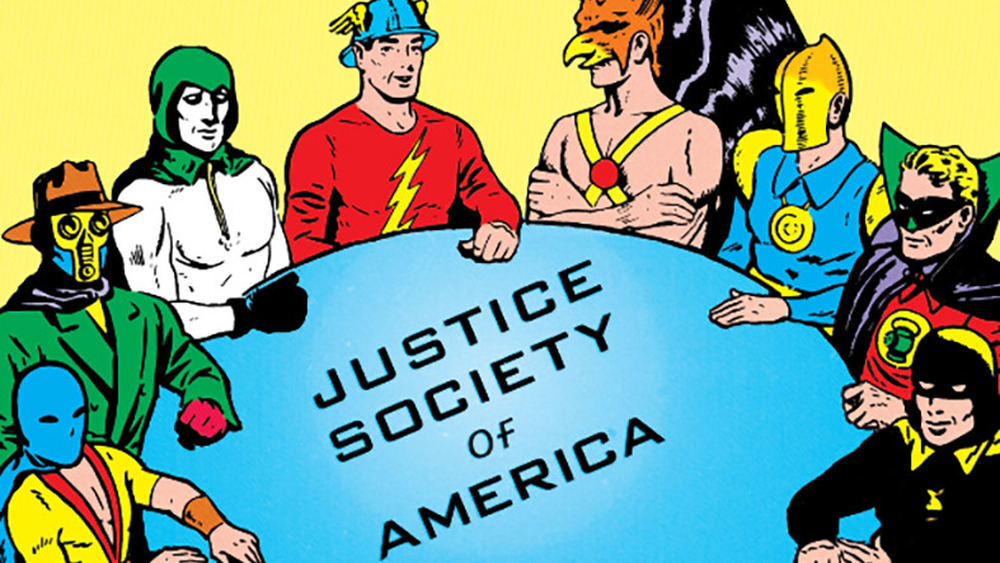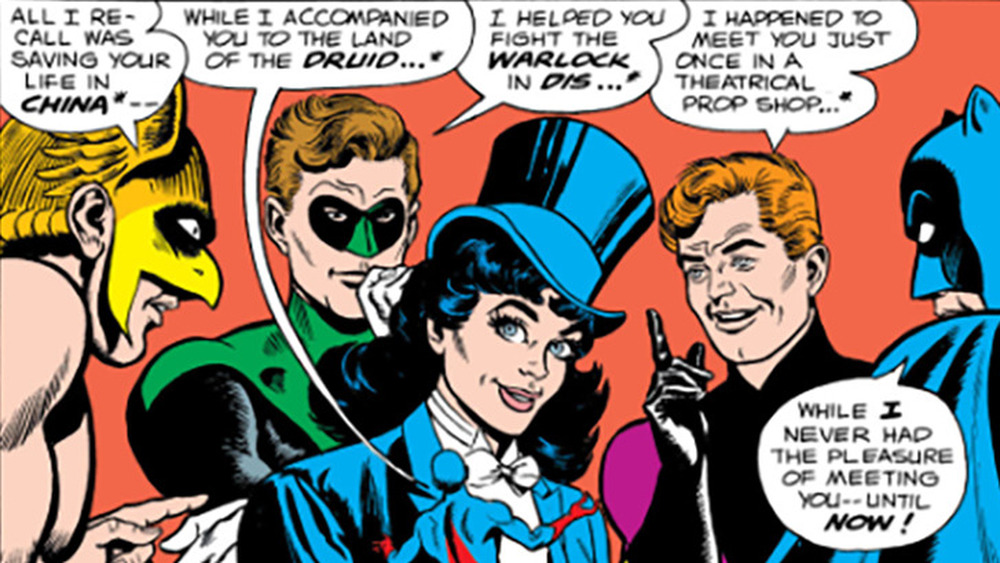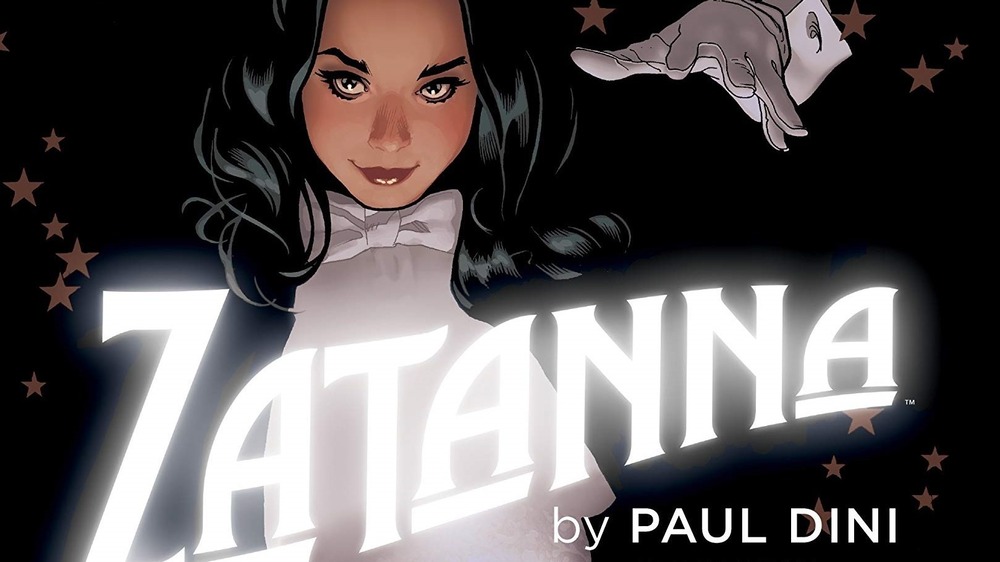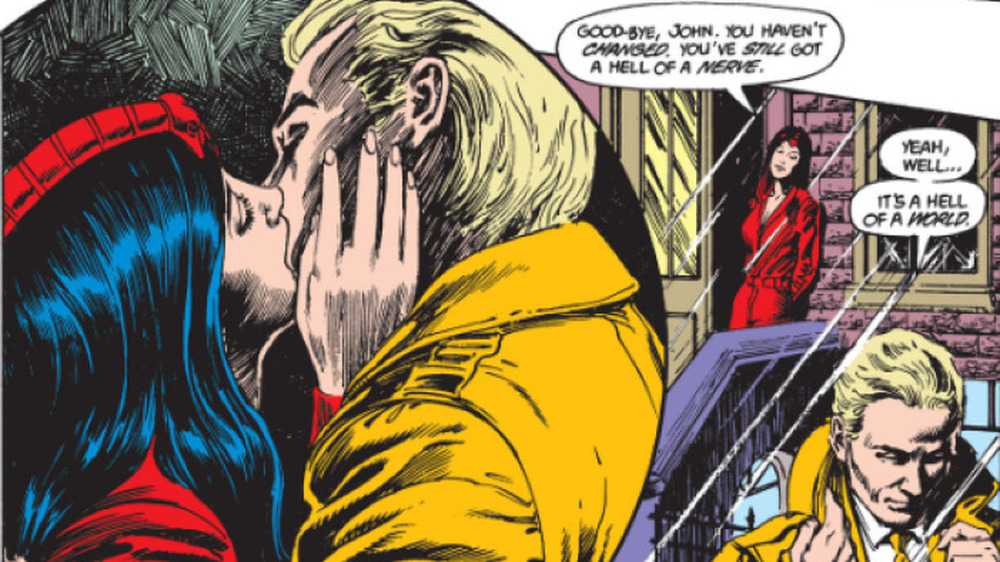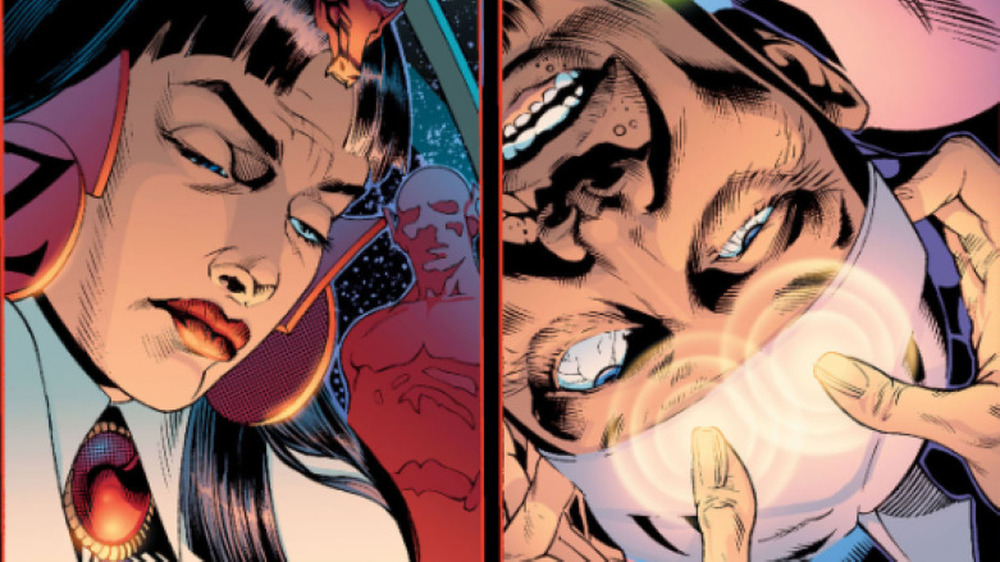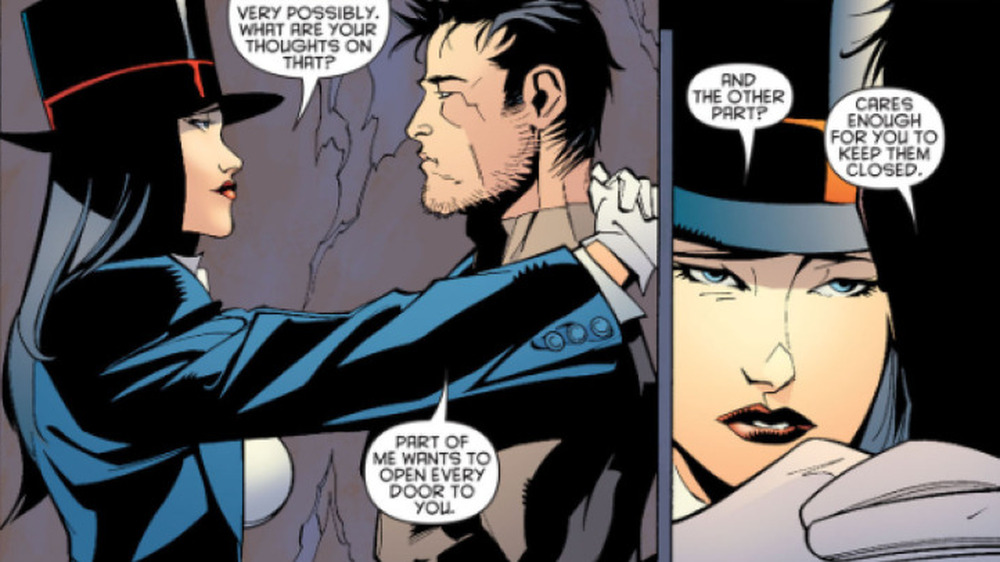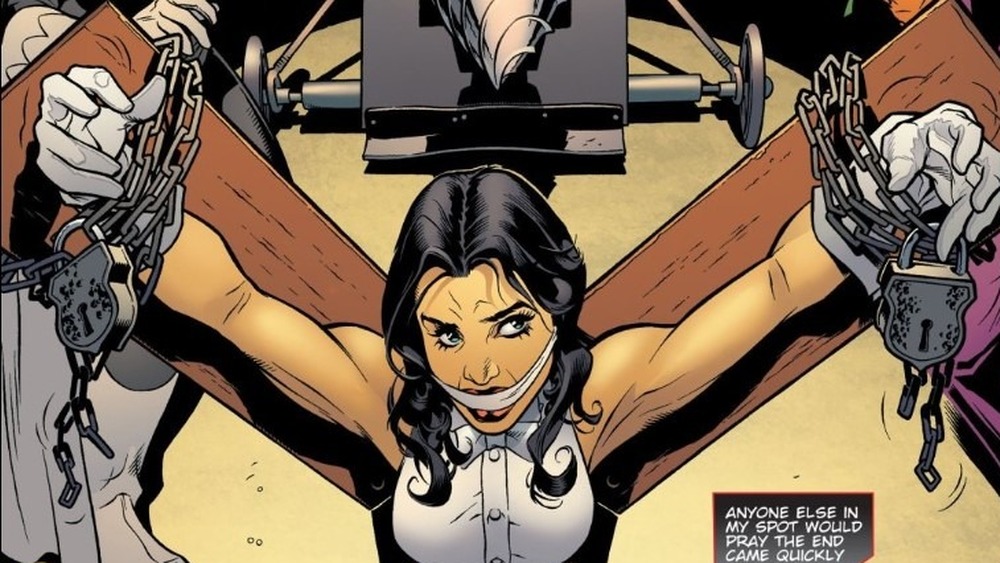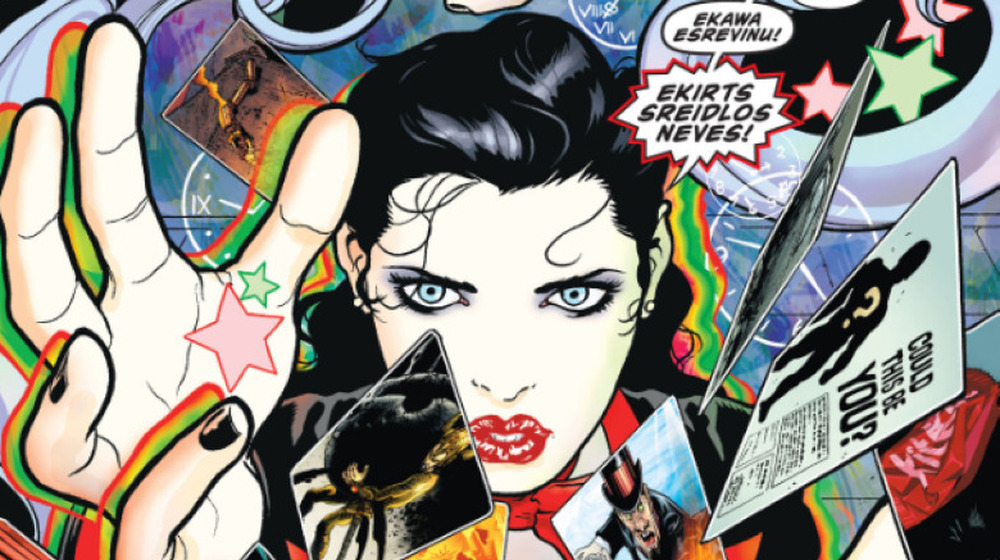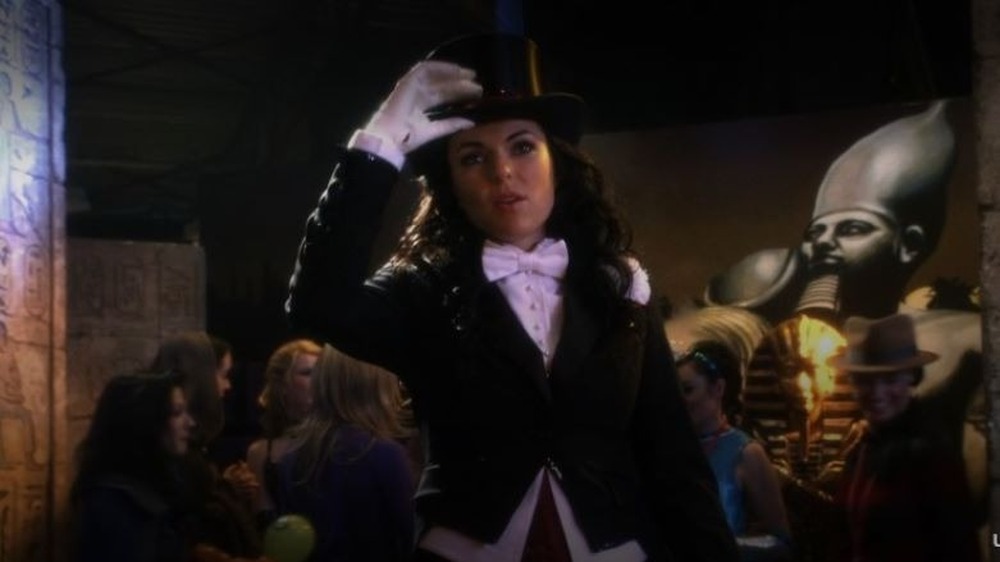The Untold Truth Of DC's Zatanna
If you only know DC characters from movies and TV, you might not know much about Zatanna Zatara. Don't be fooled by her relatively low profile — Zatanna has been a staple of comic books since the 1960s, and has a legacy that dates back to the first appearance of Superman. Zatanna is also a conceptual bridge between various eras of comic book history, and a lynchpin of the DC universe many times over. Furthermore, she's one of DC's most enduring heroines, deserving of mention in the same conversations as Supergirl, Wonder Woman, and Harley Quinn.
Beyond all of this, Zatanna is also a massively fun character. How many DC heroes can you think of who are just as comfortable tackling crime alongside the Dark Knight in the Batcave as they are getting loaded with John Constantine? How many massively powerful superhero sorcerers use their mind-bending talents to pull off a killer stage show? How many DC do-gooders have managed to use their prodigious powers by harnessing the power of a Speak & Spell? Only Zatanna combines such seemingly contradictory attributes into one person — and does it with aplomb at that. She's a hero, a performer, a master of mysticism, and a seriously cool person. For those not familiar with her, get ready to fall under Zatanna's spell as we delve into the untold truth of this iconic character.
Zatanna casts spells by speaking backwards
The first thing to explain about Zatanna is the one thing anybody who's heard of her already knows: She talks backwards. Well, not all the time, but almost always when she's casting spells. Zatanna is a magician, and, like her father, Giovanni "John" Zatara, she uses her very real arcane power to fight crime and make her on-stage magic act more impressive. Also like her father, she is known for dressing in a traditional stage magician's outfit, complete with top hat and tailed tuxedo jacket. And, yes, like her father, her sorcery is activated when she speaks the name of a desired magical effect, but backwards. For example, if she wants something to explode, she has to pronounce the word "edolpxe."
Zatanna has been around for decades, and the way her powers work has changed over the years. Speaking backwards hasn't always been considered a strict requirement for her magic -– sometimes, it's merely a means of focusing her sorcery and a way of honoring her father, who has been speaking backwards since his very first appearance in 1938. John Zatara, as it turns out, is a direct descendant of Leonardo da Vinci, and discovered his powers by reading some of Da Vinci's old notes that had been written backwards. Whether or not Zatanna needs to cast this way is ultimately irrelevant: It's her signature style, and a matter of legacy. She simply wouldn't be Zatanna if she started commanding things to "explode."
Zatanna isn't human
Zatanna might not sport fins, multiple eyes, or wings, but don't be fooled: She isn't actually human. Like her parents, Zatanna is a member of the Homo Magi race of humanity, whose members are naturally endowed with the ability to wield magic. This race has existed since the dawn of civilization, evolving alongside Homo Sapiens and frequently intermingling with them (and other species, like Atlanteans). Zatanna's powers, as a result, are not the result of simple mysticism, but are her actual genetic birthright.
This explanation, of course, was given long after John Zatara helped kick off the Golden Age of Comics. At that time, loosely explained mystical origin stories were perfectly acceptable in the burgeoning superhero genre: Indeed, Zatara's creator, Fred Guardineer, spent some time writing another character called Merlin the Magician, whom Guardineer decided should also cast spells by speaking backwards. As the medium progressed through what are now called the Silver and Bronze Ages, writers started cooking up more scientific explanations for superpowers, often retconning them into the origin stories of Golden Age characters. Thus, the Homo Magi race was born, and Zatanna became one of its representatives.
Zatanna's creator is an unsung giant of comic books
When people talk about DC Comics' history, you hear a lot of the same big names thrown around: Superman creators Jerry Siegel and Joe Shuster, Batman creators Bob Kane and Bill Finger, Wonder Woman creators William Moulton Marston and H.G. Peter. But Gardner Fox's name tends to be mentioned less frequently, despite his massive contributions to the medium. During the Golden Age, Fox created the original incarnations of the Flash, Hawkman, Hawkgirl, and Doctor Fate. He was also the writer who gave Batman his trademark utility belt, along with his Batarangs. Most impressively, he was the creative force behind the first superhero team, the Justice Society of America.
While Zatara's first appearance was written by Fred Guardineer, Fox started writing the character in 1939's Action Comics #8. When the Silver Age came along and DC started rebooting Golden Age characters wholesale, Fox put a twist on the process, introducing Zatanna in 1964 as her then-missing father's protégé. Thus, Zatanna's origins go as far back as the dawn of the superhero genre itself. Moreover, she stands as one of the most beloved and high-profile creations of the late, great Gardner Fox.
Zatanna starred in the first comic book crossover
Zatanna first appeared in the pages of Hawkman #4, as part of a storyline entitled "Zatanna's Search," which spanned six issues over the course of two years, all written by Gardner Fox. But unusually, those six issues didn't take place in sequential order under the banner of a single title. Instead, after encountering Hawkman and Hawkgirl, Zatanna bounced from The Atom to Green Lantern to Detective Comics, searching for her missing father. The storyline culminates with Zatara's official return in Justice League of America #51, by which point the affair had become the first modern, multi-title crossover in comic book history.
Crossovers would go on to become the bread and butter of both DC and its rival, Marvel Comics. Of course, modern crossovers often have their own titles, featuring a unique mix of characters. They're also a lot more careful about letting you know which issues you need to pick up to gather the pieces of the entire story. The six installments that comprise "Zatanna's Search" were released upon an uninitiated audience, without the benefit of promotional guides and marketing roll-outs. But the essential formula, which gets readers to buy multiple titles to keep up with their favorite superheroes, endures. Thus, Zatanna is the original crossover character.
It took decades to get Zatanna her own book
For most of her history, Zatanna hasn't had her own title. Following the conclusion of "Zatanna's Search," she appeared sporadically in the pages of Action Comics and Adventure Comics, as well as The Flash, Supergirl, and Justice League of America. In 1978, at the end of Justice League of America #161, she gained official membership in the Justice League, remaining part of the team through the mid-1980s. It wasn't until 1993, almost 30 years after her first appearance, that she would get her own limited series, a four-issue title simply called Zatanna. She got another one in 2005, also consisting of four issues, as part of the Seven Soldiers series.
Finally, in 2010, more than 45 years after her debut in Hawkman #4, Zatanna starred in her first ongoing solo series, written by Paul Dini and drawn by Stéphane Roux. The book lasted 16 issues. After that conclusion, Zatanna was folded back into the Justice League, this time as part of an entirely supernatural iteration called Justice League Dark. Zatanna's years as a crossover character give her a fascinating place in comic book history, but it's also probably the main reason she hasn't become a household name: She's nearly always the guest star, supporting player, or team member, and rarely the star of the show.
Zatanna has crossed over into Vertigo
Zatanna's name might not be on the cover all that often, but she makes up for this with historical importance and the sheer breadth of her appearances. Those two elements combined in 1986, when Zatanna became one of the few mainstream DC Comics characters to cross the line between comic book audiences. That was the year she appeared in Alan Moore's Saga of the Swamp Thing, in a story that kills off her father, Zatara, and establishes her romantic relationship with fellow magician and future Hellblazer protagonist John Constantine. It also loosely connects to the legendary crossover event Crisis on Infinite Earths.
Saga of the Swamp Thing was one of the first comics to officially ditch the Comics Code Authority, which had been regulating comic book content since 1954. A mature horror comic that indulges in both violence and sex, it is intended for adult readers rather than children, and was a major part of starting DC down the path that would eventually lead to the creation of Vertigo, their adult-oriented imprint. For the most part, Vertigo characters and storylines were kept separate from those of DC Comics proper, but Zatanna made the leap several times, nearly always in John Constantine stories. In Hellblazer #63, the first issue of Hellblazer published under the Vertigo name, she attends Constantine's birthday party and smokes marijuana grown by Swamp Thing. If that doesn't show off her range, we don't know what could.
Zatanna is part of one of DC's most controversial stories
If Zatanna magically puffing on a joint seems inappropriate, we have bad news for you: It's not even close to the most controversial thing she's done. In fact, about a decade after that escapade, Zatanna became involved in one of the most polarizing stories DC has ever published. 2004's Identity Crisis intends to explore the nature of ethics as they relate to superheroes. Unfortunately, it does so by having its characters –- and Zatanna in particular –- behave in shockingly unethical ways. In this story, it's revealed via flashback that, after the supervillain Doctor Light committed a sexual assault, the Justice League voted to let Zatanna alter his personality, effectively lobotomizing him. She also erased a disapproving Batman's memories of the incident, and had, as it turned out, erased other characters' memories on previous occasions.
There are many reasons to dislike Identity Crisis beyond its clumsy handling of themes it probably shouldn't have attempted to address in the first place (though that's absolutely the main reason to dislike it). One is the light in which it casts Zatanna, whose guilt over her actions contributes to her briefly losing her powers. As a story that reframes beloved characters as moral sinkholes, it's been called "the comic that ruined comics." Fortunately, every year since 2004 has taken us, and Zatanna, further away from Identity Crisis.
Zatanna has a complicated relationship with Batman
Zatanna's history with the Dark Knight technically goes back to her second-ever appearance in Detective Comics #336, but we do mean technically –- Batman and Robin battle a witch in that issue, who, Zatanna explains in Justice League #51, had actually been her in disguise. It's a mild retcon that allows Batman to join in on the conclusion of "Zatanna's Search." But Batman also says in Justice League #51 that, barring the witch encounter, he's never met Zatanna before, a statement that has since been subjected to a considerably larger retcon.
According to the new history laid out in 2007's Detective Comics #833, Gothamite John Zatara was once friends with Bruce Wayne's father. Bruce and Zatanna knew each other as children, and Zatara goes on to train an older Bruce in the skills of escape artistry. This arrangement leads to Zatanna knowing about his plans to become Batman and developing a teenage crush on him. As the years go on, their crimefighting work draws them closer together, and, in Detective Comics #843 and 844, they discuss the possibility of a romantic relationship. Zatanna ultimately nixes the idea, suspecting that Bruce's passion for her could never be stronger than his obsession with his personal demons, but they remain friends, as they have been in some form since 1965.
Silencing Zatanna is harder than it looks
The thing about having superpowers that rely on your voice is that at some point, a supervillain is going to exploit that very obvious weakness. This has historically been a problem for Zatanna, whose opponents are always trying to prevent her from speaking. Often, this is accomplished by tying her up and gagging her, incorporating Zatanna into a long and slightly uncomfortable DC Comics tradition. Her fellow heroine Black Canary, whose powers also depend on her voice, is likewise frequently gagged, and, of course, Wonder Woman has an entire thematic relationship with bondage that dates back to her origins.
Often, supervillains find more creative and drastic ways to silence Zatanna. In Detective Comics #833, for example, Zatanna is shot through the throat by the Joker. In the next issue, however, it's revealed that Zatanna wrote the words of a healing spell in her own blood, a tactic she's used several times. This is proof that, in a pinch, Zatanna doesn't actually need her voice to use magic. This concept is taken to a logical (and absurd) extreme in Zatanna #9, which shows a teenage Zatanna, inhibited by her new braces, performing magic by using a Speak & Spell.
Zatanna is among DC's most powerful superheroes
There's a reason supervillains are so anxious to shut Zatanna up: Her sorcery allows her to break the laws of physics and fundamentally alter the shape of reality. Over the years, the effects she's created range from healing to elemental control to transmutation to predicting the future –- and those are some of her more mundane spells. While you don't often see her squaring off against the likes of Doomsday or Darkseid, that's only because she's busy tackling evil magicians like Brother Night, Nimue Ravensong, and Zachary Zor, as well as extra-dimensional and demonic beings like Allura, Fuseli, and Mammon. She's also the guardian of artifacts such as the Gnosis Sphere, and maintains a vast occult library in her mystical mansion, Shadowcrest.
In a universe boasting its own modern mythology of gods and heroes, Zatanna isn't always placed in the upper echelon of DC characters. But that says more about how she's been utilized than about what she can do –- which is, theoretically, anything. As an example, probably Zatanna's single greatest feat of magic occurred in 2005, during Grant Morrison's Seven Soldiers series. At the story's climax, Zatanna casts a spell that retroactively re-writes time and space to fulfill a prophecy and defeat an alien race called the Sheeda. It's the sort of thing she can pull out of her hat at any moment, meaning that Zatanna is always ready to make her case as one of DC's most powerful heroes.
Zatanna doesn't have much of a live-action history
You would think that a character like Zatanna, with a rich history in DC Comics, strong connections to Batman and the Justice League, and an extremely high power level, would have at some point made it into the movies. But while she's been a staple of animated DC adaptations like Batman: The Animated Series, Justice League Unlimited, and Young Justice, Zatanna has never, ever appeared in a film. In fact, the character has only been adapted to any live-action medium once: She shows up for a couple episodes of Smallville. Beyond that, no DC films or television shows have bothered to cast an actress to play her on camera.
Ever since films like Shazam! broke the seal on magic in the DCEU, however, Zatanna's screen arrival has seemed more and more likely. Fans wondered if perhaps she'd show up in some sort of ensemble affair, or perhaps cameo in a Batman film. That would, after all, be historically appropriate for Zatanna. But in March 2021, it was announced that Zatanna would be getting a movie all to herself, directed by Promising Young Woman's Emerald Fennell. Such a movie represents a measure of justice for a character who has always deserved more respect than she's gotten. Zatanna making her film debut in a film called Zatanna doesn't completely make up for the indignities heaped upon her over the last 60 years (ahem, Identity Crisis), but it's certainly a start.
